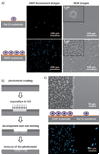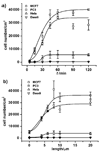Three-dimensional nanostructured substrates toward efficient capture of circulating tumor cells
- PMID: 19847834
- PMCID: PMC2878179
- DOI: 10.1002/anie.200901668
Three-dimensional nanostructured substrates toward efficient capture of circulating tumor cells
Figures




References
-
- Steeg PS. Nat. Med. 2006;12:895. - PubMed
-
- Budd GT, Cristofanilli M, Ellis MJ, Stopeck A, Borden E, Miller MC, Matera J, Repollet M, Doyle GV, Terstappen LWMM, Hayes DF. Clin. Cancer Res. 2006;12:6403. - PubMed
-
- Allard WJ, Matera J, Miller MC, Repollet M, Connelly MC, Rao C, Tibbe AGJ, Uhr JW, Terstappen LWMM. Clin. Cancer Res. 2004;10:6897. - PubMed
-
- Zieglschmid V, Hollmann C, Böcher O. Crit. Rev. Clin. Lab. Sci. 2005;42:155. - PubMed
-
- Pantel K, Brakenhoff RH, Brandt B. Nat. Rev. Cancer. 2008;8:329. - PubMed
Publication types
MeSH terms
Substances
Grants and funding
LinkOut - more resources
Full Text Sources
Other Literature Sources

